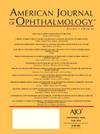Incidence and Predictors of Remission of Childhood Uveitis in a Large Community Cohort
IF 4.1
1区 医学
Q1 OPHTHALMOLOGY
引用次数: 0
Abstract
PURPOSE
To describe a large community cohort of incident cases of childhood uveitis and to determine incidence and predictors of remission.
DESIGN
Retrospective clinical cohort study.
METHODS
Participants were patients aged 16 years or younger who were newly diagnosed with uveitis at Kaiser Permanente Northern California, a large integrated health care system, between January 1, 2010, and December 31, 2020. Data were extracted electronically from medical records, pharmacy records, and health plan database. Incidence and predictors were determined using Cox regression modeling and survival analysis. The main outcome measure was the incidence of drug-free remission. For the primary analysis, remission was defined as no recurrence of active uveitis for at least 3 months beyond cessation of drug effect. Factors potentially predictive of remission were assessed.
RESULTS
Of 1643 patients with incident uveitis, 277 incident cases of noninfectious uveitis were identified, including 145 patients (52.3%) with chronic noninfectious uveitis who were treated for at least 3 months; of these, 75 patients (51.7%) were female and 102 patients (70.3%) had anterior uveitis. Mean age at initial treatment was 9.8 (SD = 4.31) years. Mean follow-up time was 41.3 (SD = 31.8) months. At 5-year follow-up, the cumulative probability of drug-free remission was 50.8% (95% CI = 41.7%-60.6%). Age at start of treatment (adjusted hazard ratio [aHR] = 1.18. 95% CI = 1.1-1.28) and male sex (aHR = 1.85; 95% CI = 1.11-3.08) were associated with higher incidence of remission. Baseline characteristics that did not reach significance included bilateral disease, anterior uveitis, posterior synechiae, cataract, juvenile idiopathic arthritis, visual acuity, tobacco exposure, and socioeconomic status. A dose–response survival effect was seen with increasing age at presentation.
CONCLUSIONS
Almost half of the children with newly diagnosed chronic noninfectious uveitis achieved drug-free remission within 5 years of follow-up, with the youngest least likely to achieve remission and the oldest most likely to achieve remission. Female sex and younger age at presentation were independent predictors of lack of remission of childhood uveitis.
大型社区队列中儿童葡萄膜炎的发病率和缓解预测因素。
目的:描述一个大型社区队列的儿童葡萄膜炎事件病例,并确定发病率和缓解的预测因素。设计:回顾性临床队列研究参与者:2010年1月1日至2020年12月31日期间,在大型综合医疗保健系统北加州凯撒医疗机构(Kaiser Permanente Northern California)新诊断为葡萄膜炎的16岁或以下患者。方法:数据以电子方式从医疗记录、药房记录和健康计划数据库中提取。采用Cox回归模型和生存分析确定发病率和预测因素。主要结局指标:无药缓解发生率。在初步分析中,缓解被定义为在药物作用停止后至少3个月内没有复发活动性葡萄膜炎。评估可能预测缓解的因素。结果:1643例葡萄膜炎患者中,发现非感染性葡萄膜炎277例,其中慢性非感染性葡萄膜炎145例(52.3%),治疗3个月以上,其中女性75例(51.7%),前葡萄膜炎102例(70.3%)。初始治疗时的平均年龄为9.8岁(标准差[SD] 4.31)。平均随访时间41.3个月(SD 31.8)。5年随访时,累计无药缓解概率为50.8% (95% CI 41.7%-60.6%)。治疗开始年龄(校正风险比[aHR], 1.18;95%可信区间[CI], 1.1-1.28)和男性(aHR, 1.85;95% CI(1.11-3.08)患者的缓解率较高。未达到显著性的基线特征包括双侧疾病、前葡萄膜炎、后粘连、白内障、青少年特发性关节炎、视力、烟草暴露和社会经济地位。剂量-反应生存效应随就诊年龄的增加而增加。结论:近一半的新诊断的慢性非感染性葡萄膜炎患儿在5年的随访中获得了无药物缓解,最小的患儿最不可能获得缓解,而最大的患儿最有可能获得缓解。女性性别和发病年龄较小是儿童葡萄膜炎缺乏缓解的独立预测因素。
本文章由计算机程序翻译,如有差异,请以英文原文为准。
求助全文
约1分钟内获得全文
求助全文
来源期刊
CiteScore
9.20
自引率
7.10%
发文量
406
审稿时长
36 days
期刊介绍:
The American Journal of Ophthalmology is a peer-reviewed, scientific publication that welcomes the submission of original, previously unpublished manuscripts directed to ophthalmologists and visual science specialists describing clinical investigations, clinical observations, and clinically relevant laboratory investigations. Published monthly since 1884, the full text of the American Journal of Ophthalmology and supplementary material are also presented online at www.AJO.com and on ScienceDirect.
The American Journal of Ophthalmology publishes Full-Length Articles, Perspectives, Editorials, Correspondences, Books Reports and Announcements. Brief Reports and Case Reports are no longer published. We recommend submitting Brief Reports and Case Reports to our companion publication, the American Journal of Ophthalmology Case Reports.
Manuscripts are accepted with the understanding that they have not been and will not be published elsewhere substantially in any format, and that there are no ethical problems with the content or data collection. Authors may be requested to produce the data upon which the manuscript is based and to answer expeditiously any questions about the manuscript or its authors.

 求助内容:
求助内容: 应助结果提醒方式:
应助结果提醒方式:


